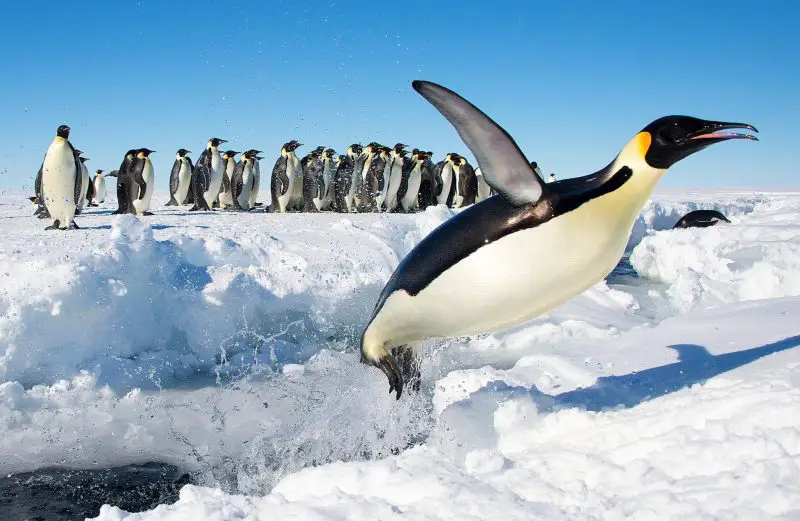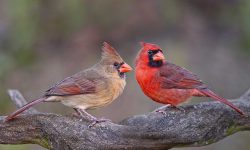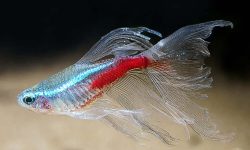In the frigid waters of the Southern Hemisphere, where survival hinges on skill, speed, and strategy, penguins have become extraordinary masters of the sea. These flightless birds, often celebrated for their adorable waddle and tuxedo-like plumage, are also elite swimmers navigating a world filled with danger. Every time a penguin dives into the ocean, it risks crossing paths with some of nature’s most lethal marine predators.
Yet penguins are not helpless prey. Far from it. With millions of years of evolution behind them, they’ve developed a suite of swimming tactics that dramatically increase their chances of survival. From lightning-fast dives to coordinated group movements and astonishing underwater acrobatics, penguins have turned evasion into an art form.
This in-depth exploration reveals how penguins survive in such a predator-packed environment. By understanding their swimming techniques and survival strategies, we gain not only admiration for these resilient birds but also a deeper appreciation of how they’ve adapted to one of the harshest ecosystems on Earth.

The Predator Threat: What Penguins Are Up Against
To understand the urgency behind penguin swimming tactics, we first need to examine the predators that make the ocean such a perilous place. While penguins may rule the icy coastlines, beneath the waves they are constantly hunted.
In the Antarctic, the most feared predator is the leopard seal. With a sleek, muscular body and powerful jaws lined with sharp teeth, this seal is a top-tier hunter. It lurks at the edge of ice shelves, waiting for penguins to plunge into the water or return from feeding. Attacks are swift and brutal, often catching penguins off-guard.
Further offshore, killer whales—or orcas—pose an even greater threat. These highly intelligent, social predators can work together in coordinated hunts. With their sheer power and speed, they are capable of tracking down even the most agile prey.
In sub-Antarctic regions like the Falkland Islands or South Georgia, sea lions and fur seals are the main aggressors. These agile swimmers patrol nearshore waters, ambushing penguins as they leave or approach land, especially during breeding season.
Finally, in temperate regions like southern Africa and South America, penguins must also contend with sharks, including great whites and sevengill sharks, which rely on stealth and ambush to strike from below.
These diverse predators attack at different angles and times, meaning penguins must be ready for anything. Their swimming behaviors are not just adaptations—they’re necessities for survival.
The Perfect Escape Artist: Penguin Physiology and Evolution
At first glance, a penguin’s body may not scream “predator evasion machine.” But look closer, and the marvels of evolution become clear. Everything about a penguin’s design—from its feathers to its flippers—is built for underwater speed, maneuverability, and endurance.
Their torpedo-shaped bodies reduce drag, allowing them to glide effortlessly through the water. Their smooth, overlapping feathers form a water-repellent barrier that helps maintain hydrodynamics and insulation.
Instead of wings for flight, penguins use rigid flippers like underwater oars. Their bones are dense and heavy, reducing buoyancy and helping them dive efficiently.
Their muscles are packed with myoglobin, allowing them to store oxygen and support long, deep dives. Some species can dive for over 20 minutes and reach depths of more than 500 meters.
Perhaps most impressively, penguins can slow their heart rates and redirect blood flow to vital organs, maximizing oxygen use during a dive. These physiological adaptations give penguins the edge when the water becomes a battlefield.
Porpoising: Speed Meets Survival
Few penguin behaviors are as iconic—or as effective—as porpoising. This rapid, rhythmic leaping in and out of the water isn’t just elegant—it’s a highly strategic move.
Porpoising allows penguins to maintain high speed while taking quick breaths mid-swim. Rather than surfacing and slowing down, they leap, inhale, and dive again in a fluid motion.
This behavior also disrupts predator tracking. The irregular trajectory and sudden splashes confuse hunters, especially visual predators like leopard seals.
Porpoising is most often used when penguins approach or leave shore—critical moments when ambushes are most likely. By minimizing time spent at the surface, they reduce their exposure to attacks and boost their odds of escape.
Group Swimming: Safety in Synchronization
Although often portrayed alone in photos, penguins are communal animals that use group strategy for safety—especially when entering or exiting the sea.
Swimming in tight groups lowers the risk of individual attacks. A predator may hesitate before charging into a swirling cluster of beaks and flippers. Even if it does strike, the confusion and chaos make it hard to focus on just one penguin.
Many species also synchronize their entries into the water, often riding the momentum of incoming waves. By timing their leap with a cresting wave, the entire group is thrust forward quickly and silently, limiting splashes and disturbance that could alert predators.
Underwater, these groups remain loosely coordinated. Their collective motion acts like a school of fish, a tactic that adds one more layer of difficulty for would-be attackers.
Zigzagging and Acrobatics: The Art of Evasion
When directly pursued, penguins switch from speed to maneuverability, transforming into underwater acrobats.
One of their key tactics is zigzag swimming. By making abrupt left and right turns, they become unpredictable targets, disrupting the predator’s path and forcing it to overcorrect.
They also execute quick pivots and mid-swim reversals, enabled by their strong flippers and flexible bodies. This kind of directional agility helps penguins dodge sudden lunges or tail swipes.
In particularly intense chases, penguins may even roll or spiral mid-dive, a disorienting move that can throw off a predator’s aim—especially for sharks, which rely on linear momentum to strike with force.
These evasive maneuvers require not just strength, but instinct, timing, and reflexes, honed over generations in some of the ocean’s most hostile environments.
Deep Diving and Ice Strategies: Seeking Refuge Below
Sometimes, the best escape isn’t sideways—but downward. Penguins are among the most proficient diving birds, and this skill becomes a lifeline when danger lurks.
By diving to extraordinary depths, penguins can outswim shallow-water hunters. Species like the emperor penguin descend hundreds of meters in search of safety or food, far beyond the reach of most predators.
In icy regions, penguins take this one step further. They utilize underwater ice ledges and submerged tunnels to evade pursuit. A fleeing penguin might slip beneath a sheet of sea ice and emerge minutes later through a distant crack, leaving its pursuer behind.
They’ve learned to pause beneath the ice, observing above before surfacing. This cautious strategy adds a level of stealth and awareness to their physical skills, blending instinct with environmental intelligence.
Explosive Speed and High-Impact Landings
While penguins may not match dolphins or tuna in cruising speed, they are capable of explosive acceleration. Many can reach 15 kilometers per hour, a burst fast enough to escape all but the quickest predators.
What truly sets them apart, though, is their ability to leap from the water. A penguin chased by a predator can build speed and launch itself vertically onto ice ledges, slippery rocks, or even snowy cliffs.
These leaping landings are executed with incredible timing and strength. They serve as the final act of escape, putting a physical barrier between penguin and predator. Since seals and sharks cannot follow out of water, the leap can mean the difference between life and death.
The Learning Curve: How Juvenile Penguins Adapt
Penguin chicks don’t have years to learn. As soon as they fledge, they must enter the ocean and face predators head-on.
Young penguins often start by exploring shallow bays or tide pools, where they can practice diving, turning, and surfacing without immediate threat.
They also follow adult role models, mimicking their group behaviors and response patterns to danger. This early mentorship is vital; those who learn quickly and adapt rapidly are the ones who survive their first months at sea.
Evolution at Work: Adapting Through Pressure
Life in the predator-filled oceans of the Southern Hemisphere is unforgiving. Every dive a penguin takes could be its last. This constant exposure to danger has placed enormous evolutionary pressure on penguin populations for millions of years. As a result, only those individuals with the sharpest reflexes, most efficient bodies, and strongest survival instincts have passed their genes on to the next generation.
Over time, this intense process of natural selection has sculpted penguins into remarkably specialized creatures. Every species, depending on its environment and the types of predators it faces, has developed distinct survival traits—physical, behavioral, and physiological—that enhance its chances of avoiding death at sea.
For example, emperor penguins, the largest of all penguin species, have adapted to dive longer and deeper than any of their relatives. In their harsh Antarctic habitat, food sources like fish and squid are often located far beneath the surface. To access these, emperor penguins evolved incredible oxygen efficiency, large oxygen-storing muscles, and the ability to slow their heart rate drastically during dives. These adaptations not only aid in foraging but also allow them to evade predators such as leopard seals by escaping to depths other hunters cannot follow.
In stark contrast, rockhopper penguins, which inhabit rocky coastlines and island cliffs in sub-Antarctic regions, have evolved for speed and agility rather than depth. These smaller penguins are known for their ability to leap between sharp rocks and navigate treacherous coastal terrain with ease. In the water, they use quick, darting movements and rapid directional changes to dodge fast-approaching predators like fur seals. Their compact, muscular build and extremely responsive nervous systems make them well-suited to high-risk environments where close encounters are frequent and escape depends on reaction time.
Other species like the Adélie and chinstrap penguins have developed adaptations specific to icy environments, such as ice-edge awareness, enhanced group coordination, and environmental memory, which help them predict predator behavior and plan safer travel routes.
These specialized traits are not random—they are the result of countless generations surviving by fractions of a second or a few meters of distance. In evolutionary terms, it’s a constant arms race: as predators become faster or smarter, penguins must evolve even better strategies to keep up. Those that fail to adapt perish, while those with the most effective defenses become the architects of the next generation.
In this way, the diversity among penguin species reflects not just where they live, but also how they’ve survived. Each adaptation—whether it’s deep-diving lungs, cliff-jumping legs, or agile flippers—is a living legacy of millions of years spent battling against the ocean’s most formidable hunters.
A Delicate Balance: Human Impact on Survival
For millions of years, penguins have relied on finely tuned instincts and remarkable physical adaptations to survive in some of the most hostile environments on Earth. But today, a new kind of threat looms—one they cannot outswim, outmaneuver, or evolve to escape. This threat doesn’t come from below the waves or across the ice. It comes from us.
Despite their elite swimming abilities and natural defenses, penguins now face growing challenges driven by human activity, disrupting the delicate balance between predator, prey, and habitat that their survival depends on.
One of the most immediate dangers is overfishing. In many regions, industrial-scale fishing operations deplete the same fish stocks penguins rely on—such as anchovies, sardines, krill, and squid. As prey becomes scarcer, penguins are forced to swim farther, dive deeper, and spend more time at sea in search of food. This not only burns valuable energy but also dramatically increases their exposure to marine predators like sea lions, leopard seals, and sharks. Chicks left behind in colonies may starve as adults struggle to return in time with food.
Pollution poses another growing threat, particularly oil spills, which can be devastating to penguin populations. A single spill can coat thousands of birds in toxic slick, destroying the waterproof properties of their feathers. Without that insulation, penguins quickly become waterlogged and hypothermic in icy seas. Even small amounts of oil can impair swimming, diving, and feeding.
Likewise, plastic waste—now ubiquitous in oceans—entangles penguins or is ingested by mistake. Microplastics consumed by their prey may accumulate in penguin systems over time, with still-unknown long-term effects on their health, fertility, and lifespan. The ocean, once their sanctuary, is becoming a minefield of debris.
And perhaps most dangerously of all is the slow but relentless force of climate change. Rising global temperatures are melting the ice shelves and sea platforms that many Antarctic and sub-Antarctic penguin species depend on. These icy landscapes serve not only as breeding grounds but also as safe launch points and escape routes from predators. As the ice retreats, colonies are pushed closer to the water’s edge—closer to danger, with fewer natural defenses.
In regions like the Antarctic Peninsula, where warming is occurring faster than nearly anywhere else on Earth, some penguin species are already in decline, while others—less specialized for the cold—are beginning to expand into newly opened habitats. This shift is leading to competition between species, altered food webs, and rising stress on fragile ecosystems.
Beyond the physical impacts, climate change also disrupts penguin timing. Warmer temperatures shift the availability of krill blooms or fish schools, forcing penguins to adjust their breeding cycles or feeding patterns. When food is no longer abundant during the critical chick-rearing window, entire generations may be lost.
In short, the challenges penguins face today are no longer just natural—they are systemic, global, and deeply intertwined with human choices. These intelligent, resilient swimmers have evolved to evade nature’s sharpest predators, but they are ill-equipped to confront threats that alter entire ecosystems.
The survival of penguins now depends not just on their own instincts, but on our willingness to change course—to protect the oceans they depend on, reduce our environmental impact, and ensure that these remarkable birds continue to leap through waves, dive through depths, and live wild and free for generations to come.
Conclusion: Nature’s Resilient Navigators
Penguins are not just cute icons of the Southern Hemisphere. They are masters of survival, equipped with one of nature’s most refined sets of swimming and evasion skills.
Whether it’s porpoising through waves, diving into the abyss, or launching onto an icy perch, every movement is purposeful. Every tactic is born of evolution, instinct, and necessity.
As the threats they face multiply, the world must pay closer attention to these flightless, fearless swimmers. Their future may depend on our understanding—and our action.






